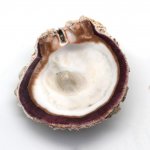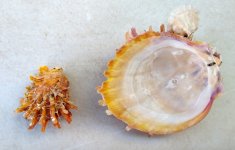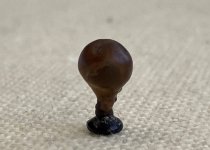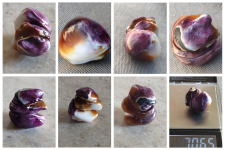Here we have another species that can make a non-traditional (non-nacreous) pearl: it is the Purple-lip Rock Oyster. The pearl could come out white, like the center of the shell and it would have no monetary value, but if it is purple like the edge then the pearl starts to be a valuable one.
Purple Hinged Rock Scallop (Crassodoma gigantea) A true scallop. [TABLE="class: infobox biota, width: 200"]
[TR]
[TD]Kingdom:[/TD]
[TD]
Animalia[/TD]
[/TR]
[TR]
[TD]Phylum:[/TD]
[TD]
Mollusca[/TD]
[/TR]
[TR]
[TD]Class:[/TD]
[TD]
Bivalvia[/TD]
[/TR]
[TR]
[TD]Order:[/TD]
[TD]
Pectinida[/TD]
[/TR]
[TR]
[TD]Family:[/TD]
[TD]
Pectinidae[/TD]
[/TR]
[TR]
[TD]Genus:[/TD]
[TD]
Crassadoma
Bernard, 1986 [SUP]
[2][/SUP][/TD]
[/TR]
[TR]
[TD]Species:[/TD]
[TD]
C. gigantea[/TD]
[/TR]
[/TABLE]
Crassadoma gigantea is found on the Pacific Coast of North America, from British Columbia south to Baja, California[SUP]. [/SUP]Unlike other pelagic (swimming) scallops, these do not move around as an adult but live on the sea floor, inside crevices and under boulders, or cemented to rock surfaces, corals or man-made structures.Found at depths down to about 80 metres (260 ft).
Rock scallops are a favorite collectible food source for recreational divers. The large white adductor mussel is a considerable delicacy and often preferred raw. Incidence of pearls is common in this species. While many are highly calcareous, wholly or partial affixed to the shell, some pearls present with lustrous surfaces, deep irregular patterns and soft white color tones. Purple pearls may occur, but color is not singularly exclusive to valuation.
This shell is highly targeted by acid boring sponges. Boring sponges aren’t named thus because they’re mundane; rather, they make their homes by drilling holes into calcium carbonate shells. Using chemicals, they etch into the shell and then mechanically wash away the tiny shell chips, slowly spreading holes within the skeleton or shell and sometimes across its surface. Eventually, these holes and tunnels may penetrate the pallial cavity of the scallop, giving rise to blister type pearls or in extreme cases may kill their host, but the sponge will continue to live there until the entire shell has eroded away.
Scallop pearl from Tofino, BC. Canada.:
https://en.wikipedia.org/wiki/Scallop#/media/File:Scallop_pearl2.jpg







